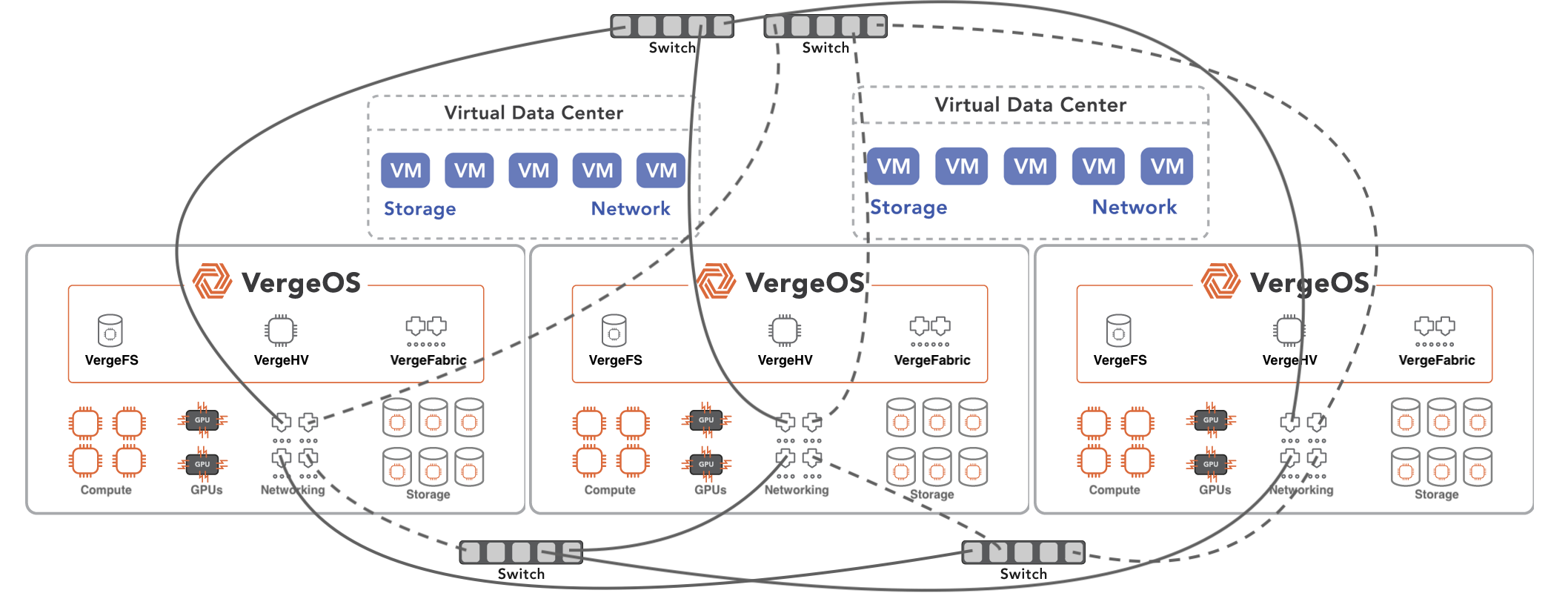Total Cost of Ownership (TCO) is a vital part of any IT decision, and the TCO of a VMware alternative is no exception. Our recent survey of VMware customers found that IT professionals are looking for a VMware alternative to do more than just lower licensing costs. They are looking for a solution that can lower the cost of the entire infrastructure, both upfront and long-term. The problem is that most alternatives focus solely on upfront license costs, masking simplicity behind strict hardware requirements, eventually increasing the total cost of ownership (TCO).
Reducing Infrastructure Operation Costs
Lowering the TCO of a VMware alternative requires that IT can reduce one of the most significant costs outside of the license, which is the time cost of people operating it. The problem is that most alternatives use a similar approach to deliver infrastructure services as VMware. They use a layer or stacked approach, squeezing separate pieces of software onto a server. However, VMware alternative vendors complicate things because they typically use open-source components that were not originally designed to work together. They try to emulate integration by adding a “custom” graphical user interface (GUI).
The layered approach, correctly labeled “the stack,” adds significant overhead and slows down operations as the loosely connected components try to exchange information between themselves. Each layer in the stack often requires a virtual machine and its high-availability functionality. When you navigate this stack, its overhead becomes evident as you interact with the GUI. Once burdened with only a few dozen virtual machines, the interface can take 30 seconds or more to refresh or update with each interaction. This refresh time leads to hours a day waiting for screen refreshes.
VergeOS – Integrated Operational Simplicity

VergeOS is unique in the infrastructure software market in that it provides a fully integrated solution. There is no stack. A single piece of software provides all the functionality that the above VMware Alternatives try to cobble together. VergeOS includes an enterprise-class hypervisor, storage services, and networking functionality. The result is an operational experience that enables IT professionals to move through their day seamlessly. As our customer, SkiBig3 stated in a recent webinar, “I don’t spend all day in the VergeIO interface. I get what I need to get done and then take care of other tasks. Managing infrastructure is something I get done a few minutes per day instead of hours.”
Reducing Infrastructure Hardware Costs
Lowering infrastructure hardware costs can also lower the TCO of a VMware Alternative. The problem is that most alternatives deliver the exact opposite. In the name of “simplification,” they require that you purchase a turnkey solution from them or buy hardware from a certified vendor. The configurations are often designed to compensate for the inefficiency of their stack.
In addition, most VMware alternatives lack built-in, integrated storage functionality and networking capabilities, or they use a stand-alone open-source component. This shortcoming either forces customers to purchase dedicated storage arrays and network appliances for routing and firewalls or learn and configure another piece of infrastructure software.
VergeOS – Bring Your Own Hardware
Over 95% of the organizations we speak to have server hardware suitable for hosting VergeOS. This support flexibility is another of the by-products of delivering a fully integrated solution. At VergeIO, we have never forced customers to upgrade hardware to support an upcoming version of VergeOS. Our customers often mix six-year-old hardware with three-month-old hardware and manage it all from a single instance of our solution. The result is an infrastructure that evolves with your needs and the practicality of hardware innovation.
Integrating storage and networking services into VergeOS means that IT professionals can gradually eliminate the need for dedicated storage arrays and networking appliances. This integration has the added benefit that the entire infrastructure is now aware that they exist. For example, VergeOS integrates deduplication at its core, which means both the hypervisor and network are “dedupe aware.” The result is that the deduplication, since it is integrated into the core of VergeIO, lowers compute and networking requirements in addition to storage capacity.
Reducing Infrastructure Upgrade Costs

Part of reducing the TCO of a VMware alternative is ensuring that the cost of upgrading the infrastructure doesn’t become prohibitive. Customers are looking to escape the VMware practice of no longer supporting certain hardware as new versions of its software are released. Given infrastructure software’s potential to provide high availability and redundancy, IT professionals should be free to run existing hardware for years while gradually mixing in newer hardware. Organizational demand should drive hardware upgrades, not software inefficiencies.
The turnkey hardware approach and strict hardware compatibility guides that some infrastructure software vendors employ make upgrades difficult. In most cases, all the servers must be refreshed at once instead of gradually replaced as needed or required by age. This practice also makes it difficult to solve a specific problem, such as if the infrastructure only needs more storage capacity but not additional computing power.
VergeOS – Future Scale
VergeOS is designed to enable IT professionals to adapt their infrastructure gradually as the needs of the business demand it. It supports dramatically different nodes within the same instance. Servers can be from different vendors, generations or brands of processors, and configurations (storage-heavy, compute-heavy, GPU-enhanced). VergeOS uses off-the-shelf NVMe-Flash and Hard Disk Drives, making capacity less expensive than dedicated storage arrays by a factor of five or more while delivering a robust set of enterprise-class storage services.
VergeOS’s capability to integrate with existing and diverse hardware components underscores its value proposition in reducing the overall TCO. By eliminating the need for dedicated storage arrays and networking appliances and by allowing for a gradual, need-based hardware upgrade path, VergeOS presents a sustainable model that aligns with the practical realities of IT budgeting.
Conclusion
Evaluating the TCO of a VMware alternative requires a holistic approach and an understanding of the triggers that can increase TCO. IT professionals must consider the operational, hardware, and upgrade costs associated with infrastructure software. VergeOS stands out by offering a fully integrated solution that simplifies the operational process and significantly reduces the reliance on expensive, dedicated hardware and the costs associated with upgrading and scaling infrastructure. This integrated approach allows for a seamless operational experience and a more cost-effective, flexible hardware strategy, setting a new standard in the industry for efficiency and adaptability.
Are you ready to map out your VMware Exit? Schedule a 15-minute session with one of our experts, and we will create a custom step-by-step transition guide for you.



